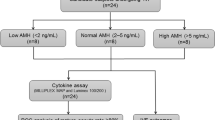Summary
To investigate the relationship between the ATP content in human oocytes and the developmental potential of human oocytes, unfertilized oocytes from clinical IVF and immature oocytes unsuitable for ICSI were collected. The ATP content of these unfertilized andin vitro matured eggs were determined quantitatively by measuring the luminescence using an ATP-dependent bioluminescence assay. The result showed that the ATP content of unfertilized oocytes was higher thanin vitro matured ones (2.20±0.67 pmol vs 1.72±0.49 pmol,P<0.05). In unfertilized oocytes, the ATP content of those whose fertilization rates (FR) was higher than 50% was 2.43±0.60 pmol, which was significantly different from those whose FR was less than 50% (1.72±0.56 pmol), while inin vitro matured oocytes, the ATP content of those whose FR more than 50% was 1.8±0.44 pmol, slightly higher than those less than 50% (1.55±0.40 pmol), without statistical significance. There was a tendency that the ATP content of oocytes of pregnant patients was higher than those of controls, but the sample number was too small to show any significance in statistics. Briefly, there was positive correlation between the ATP content in oocytes and developmental potential of oocytes.
Similar content being viewed by others
References
Barnett D K, Bavister B D. What is the relationship between the metabolism of preimplantation embryos and their developmental competence? Mol Reprod Dev, 1996,43:105
Leese H J, Biggers J D, Mroz F Aet al. Nucleotides in a single mammalian ovum or preimplantation embryo. Anal Biochem, 1984,140:443
Stojkovic M, Machado S A, Stojkovic Pet al. Mitochondrial distribution and adenosine triphosphate content of bovine oocytes before and after in vitro maturation: correlation with morphological criteria and developmental capacity after in vitro fertilization and culture. Biol Reprod, 2001,64:904
Freistedt P Stojkovic P, Wolf Eet al. Energy status of nonmatured and in vitro-matured domestic cat oocytes and of different stages of in vitro-produced embryos: enzymatic removal of the zona pellucida increases adenosine triphosphate content and total cell number of blastocysts. Biol Reprod, 2001,65:793
Van Blerkom J, Davis P, Lee J. ATP content of human oocytes and developmental potential and outcome afterin vitro fertilization and embryo transfer. Hum Reprod, 1995,10:415
Wilding M, Dale B, Marino Met al. Mitochondrial aggregation patterns and activity in human oocytes and preimplantation embryos. Hum Reprod, 2001,16:909
De Vos A, Van de Velde H, Joris Het al. In vitro matured metaphase-I oocytes have a lower fertilization rate but similar embryo quality as mature metaphase-I oocytes after intracytoplasmic sperm injection. Hum Reprod, 1999,14(7):1859
Lee S H, Han J H, Cho S Wet al. Mitochondrial AT-Pase 6 gene expression in unfertilized oocytes and cleavage-stage embryos. Fertil Steril, 2000,73(5):1001
Cohen J, Scott R, Schimmel Tet al. Birth of infant after transfer of anucleate donor oocyte cytoplasm into recipient eggs. Lancet, 1997,350:186
Van Blerkom J, Sinclair J, Davis P. Mitochondrial transfer between oocytes: potential applications of mitochondrial donation and the issue of heteroplasmy. Hum Reprod, 1998,13(10):2857
Tarin J J. Aetiology of age-associated aneuploidy: a mechanism based on the “free radical theory of ageing”. Hum Reprod, 1995,10:1563
Kitagawa T, Suganuma N, Nawa Aet al. Rapid accumulation of deleted mitochondrial deoxyribonucleic acid in postmenopausal ovaries. Biol Reprod, 1993,49:730
Keefe D L, Niven-Farchild T, Powell Set al. Mitochondrial deoxyribonucleic acid deletions in oocytes and reproductive aging in women. Fertil Steril, 1995,64:577
Brenner C A, Wolny Y M, Barritt J Aet al. Mitochondrial DNA deletion in human oocytes and embryos. Mol Hum Reprod, 1998,14(9):887
Hsieh R H, Tsai N M, Au H Ket al. Multiple rearrangements of mitochondrial DNA in unfertilized human oocytes. Fertil Steril, 2002,77(5):1012
Author information
Authors and Affiliations
Additional information
HUANG Rui, female, born in 1972, Postgraduate
Rights and permissions
About this article
Cite this article
Rui, H., Guanglun, Z. & Qun, L. Relationship between ATP content and the developmental potential of human oocytes. Current Medical Science 23, 62–64 (2003). https://doi.org/10.1007/BF02829466
Received:
Published:
Issue Date:
DOI: https://doi.org/10.1007/BF02829466




